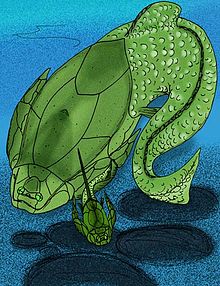Asterolepis (fish)
|
Asterolepis Temporal range: Middle to Late Devonian |
|
|---|---|
 |
|
| Reconstruction of Asterolepis | |
| Scientific classification | |
| Kingdom: | Animalia |
| Phylum: | Chordata |
| Class: | †Placodermi |
| Order: | †Antiarchi |
| Family: | †Asterolepididae |
| Genus: |
†Asterolepis Eichwald, 1840 |
| Species | |
|
See text |
|
See text
Asterolepis is an extinct genus of antiarch placoderms from the Devonian of North and South America and Europe. They were heavily armored flat-headed benthic detritivores with distinctive jointed limb-like pectoral fins and hollow spine. The armor plate gives the Asterolepis a box-like shape. Its pectoral fins are also armored but the caudal and dorsal fin are not. The first fossils were named by M. Eichwald in 1840 after noticing star-like markings on the fossils.
"Aster-" means star while "-lepis" means scales. Confusion surrounded the first fossils discovered of this genus, as naturalists were unable to ascertain their place among fishes and they were first named Chelonichthys. Later very fine specimens were found in the Old Red Sandstone of Russia and Professor Asmus of Dorpat sent them to the British Museum, noticing fossils exhibited star-like markings. That is when the name Chelonichthys was abandoned for Asterolepis which Eichwald proposed.
Primitive features such as jaw ossifications, a palatoquadrate, and a Meckel's cartilage are present in the Asterolepis that are important features shared between antiarchs and other Gnathostomata. Additionally the Asterolepis has box-like dermal armour covering the head and thorax with highly modified pectoral fins that are enclosed in interlocking dermal plates protecting a cartilaginous endocranium and gill region. Also, the vertebral column and the pectoral girdle are cartilaginous. The Asterolepis does not have an anal fin or pelvic fins. However it does have a caudal and dorsal fin. Both are covered in similar scales.
...
Wikipedia
